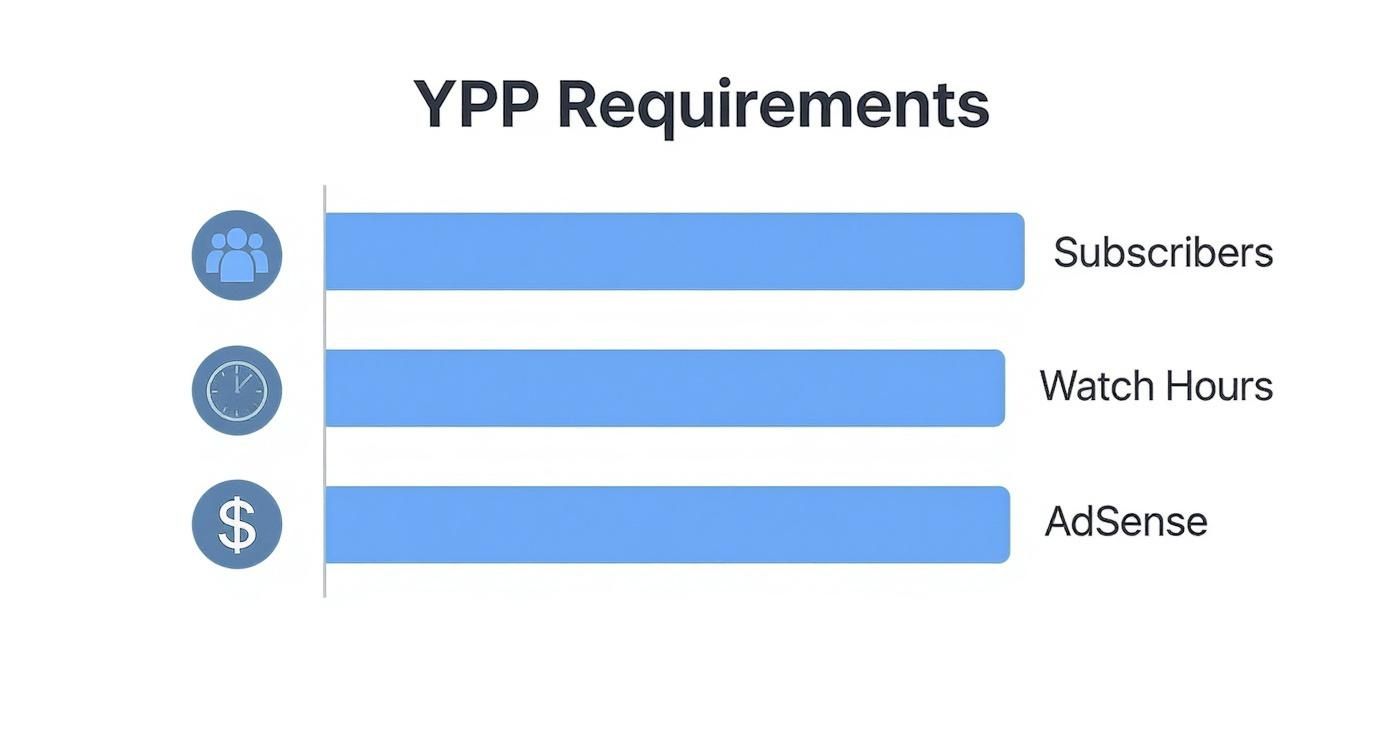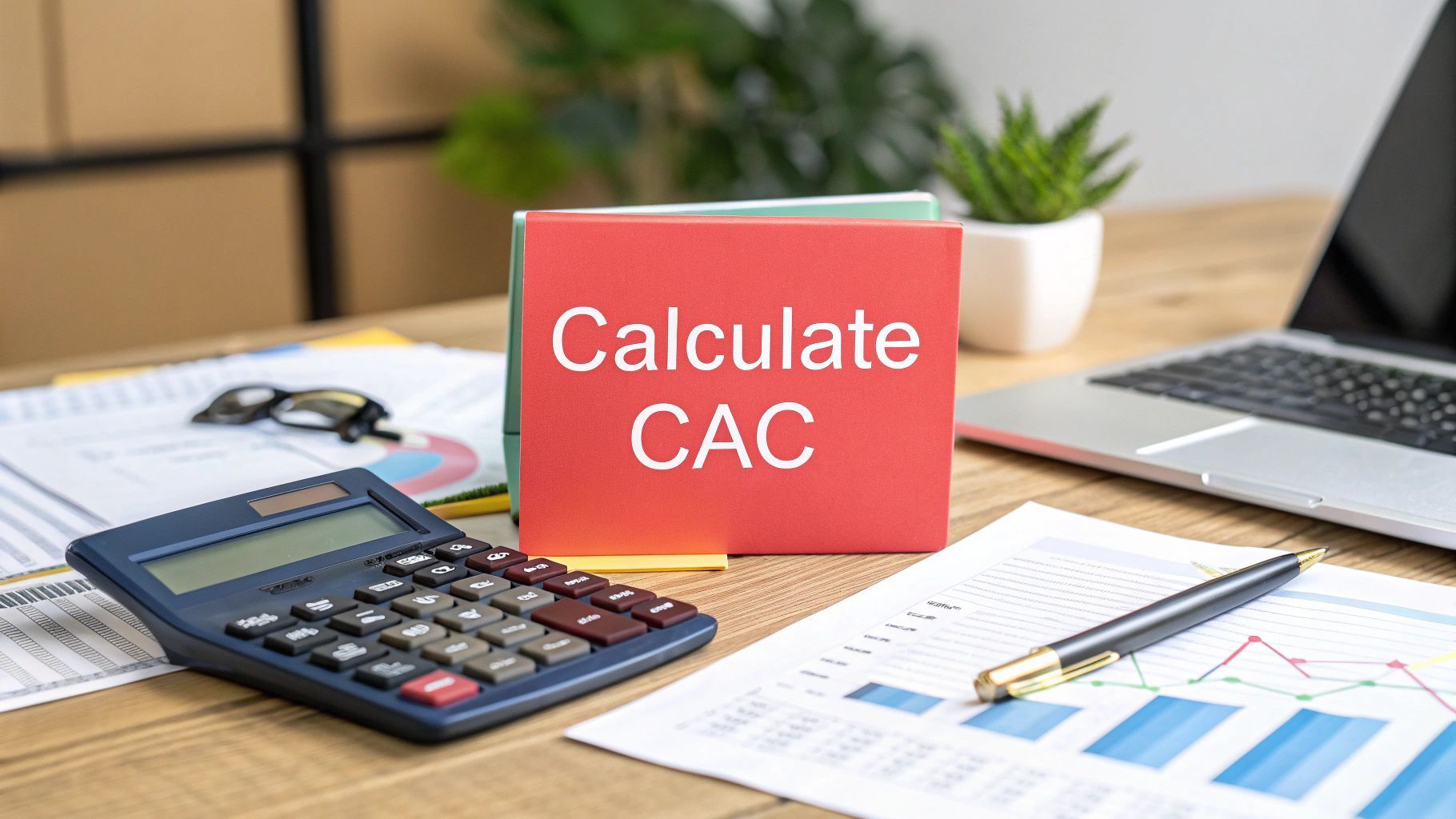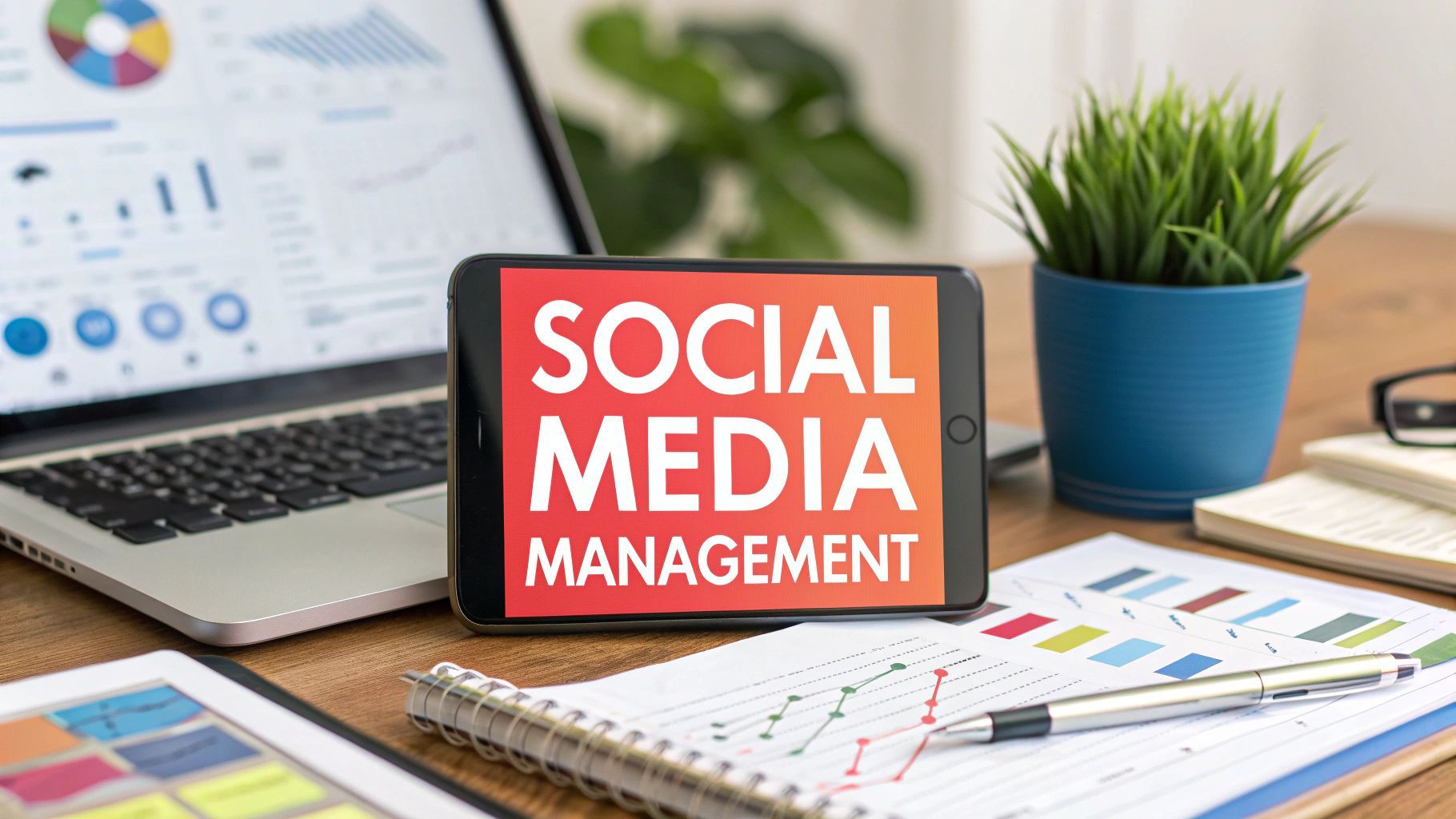Guide: how to monetise your YouTube channel for UK creators
So, you want to start earning from your YouTube channel. The first port of call is getting into the YouTube Partner Programme (YPP) . This is the official gateway and it involves hitting some key numbers, playing by YouTube's rules and linking up an AdSense account. Think of it as the foundation for turning your creative work into a real revenue stream.
Meeting YouTube's Monetisation Requirements
Before you can even dream about ad revenue or channel memberships, you have to be accepted into the YPP. This isn't just about hitting a couple of metrics; it's about proving your channel is a valuable and compliant part of the YouTube community.
Lots of creators get fixated on the numbers but YouTube’s review process looks at the bigger picture. They’re checking to see if your content genuinely adds value and doesn't bend or break their extensive guidelines. Your channel's entire history is effectively your CV for this application.
The Core YPP Eligibility Thresholds
To get your foot in the door, you have to meet a minimum set of criteria. These are the non-negotiables that your channel needs to hit and maintain.
Here are the main thresholds you need to cross:
- 1,000 Subscribers : This shows you’ve built a foundational audience that’s genuinely interested in what you’re creating.
- 4,000 Valid Public Watch Hours : This has to be within the last 12 months. It proves people aren’t just subscribing; they're actively watching and engaging with your long-form videos.
- 10 Million Valid Public Shorts Views : This is the alternative to watch hours and it needs to be achieved in the last 90 days. It reflects just how important short-form content has become on the platform.
Just to be clear, you only need to meet either the watch hour requirement or the Shorts views requirement, along with having 1,000 subscribers. You don’t need to hit all three.
Staying in Good Standing with YouTube
Hitting the numbers is only one piece of the puzzle. Your channel also has to stick to all of YouTube’s policies and guidelines. This is what YouTube calls being in "good standing."
This means your channel must have:
- No active Community Guideline strikes. These are handed out for content that violates policies on things like hate speech, harassment or dangerous content. A single active strike will make you ineligible.
- Two-Step Verification turned on for your Google Account. A simple but mandatory security step to protect your channel from being compromised.
- Adherence to the YouTube Channel Monetisation Policies. This is a broad set of rules covering everything from spam and deceptive practices to making sure your content is advertiser-friendly.
At the end of the day, YouTube wants to partner with creators who contribute positively to the platform. Any history of policy violations can put your application in serious jeopardy, even if your subscriber and watch time numbers are through the roof. For creators who find this all a bit daunting, a structured approach like a YouTube monetisation package can offer the guidance needed to stay on the right side of the rules.
A classic mistake is using copyrighted music or video clips without permission. This can lead to Content ID claims or copyright strikes, which will block your channel from being monetised and could even get it shut down. Always use royalty-free assets or get the proper licences.
Setting Up Your AdSense Account
Once you meet all the criteria, you’ll be prompted to apply for the YPP right inside the YouTube Studio. A crucial part of this application is linking an approved Google AdSense account. This is the platform Google uses to actually pay you your share of the revenue.
You are only allowed to have one AdSense account in your name. If you already have one from a blog or another project, you must link that existing account. Trying to create a second one will only lead to delays or a flat-out rejection. The setup itself is straightforward but be meticulous with your personal and payment information to avoid headaches down the line.
Maximising Your Ad Revenue as a UK Creator
So, you’ve made it into the YouTube Partner Programme (YPP). Congratulations! This is where the hard work starts to pay off and your views begin turning into actual revenue. For most creators, ad revenue is the first and often most reliable, income stream. Getting your head around how it all works is the first step to building a proper career on the platform.
Navigating YouTube advertising isn't just about switching it on and hoping for the best. It means getting to grips with the different ad formats, figuring out where to place them and understanding that mysterious metric everyone talks about: CPM. Find that sweet spot between a healthy income and keeping your audience happy and you're golden.
Before we dive into the nuts and bolts of ad types, this infographic breaks down the core YPP requirements. It’s a great visual reminder of the milestones you need to hit to get your monetisation journey started.

As you can see, while subscribers are a big part of the picture, it’s that consistent viewership – whether from long-form videos or Shorts – that really unlocks the door.
Understanding Different Ad Formats
YouTube gives you a fair bit of control over the types of ads that show up on your content. The right mix is crucial for maximising what you earn without sending viewers clicking away in frustration.
To help you decide what's best for your channel, here’s a quick breakdown of the most common ad formats you'll encounter as a UK creator.
YouTube Ad Formats Comparison for UK Creators
| Ad Format | Description | Best For | Revenue Potential |
|---|---|---|---|
| Skippable In-Stream Ads | The classic pre-roll or mid-roll ad that viewers can skip after five seconds. You get paid if they watch for at least 30 seconds or interact with it. | General use on most videos, especially those over 8 minutes long. They offer a good balance between revenue and viewer tolerance. | High |
| Non-Skippable Ads | These ads are shorter, typically 15-20 seconds , and must be watched in full. | Videos where you have a highly engaged audience that is less likely to be put off. Can be effective for shorter, high-impact content. | Very High |
| Bumper Ads | Quick, 6-second non-skippable ads. They are designed to deliver a punchy message without being too intrusive. | Placing at natural breaks in longer content or as a less disruptive pre-roll option on shorter videos. | Medium |
| Overlay Ads | Semi-transparent banner ads that appear at the bottom of the video player on desktop. They are becoming less common. | A supplementary, non-intrusive ad format that contributes a small amount to your total earnings. | Low |
Choosing the right combination really depends on your content style. For a long, deep-dive video, a mix of skippable mid-rolls and the odd bumper ad can work wonders. But for a shorter, punchier clip, a single pre-roll ad is probably all you need.
The Mystery of CPM and Why Your Niche Matters
Let’s talk about CPM, or Cost Per Mille . This is simply the amount an advertiser pays for every 1,000 times an ad is shown on your video. It’s a huge deal because it directly affects your earnings but it can swing wildly from one channel to another. A UK creator making gaming content, for instance, will almost certainly have a lower CPM than someone talking about personal finance or property investment.
So, what gives? It all comes down to the audience. Advertisers will pay a premium to get their products in front of people with specific interests or high spending power. Niches like finance, tech and business attract big-ticket ads because the services being promoted—think investment platforms or enterprise software—have a massive customer lifetime value.
A common mistake is thinking all views are created equal. They’re not. A view from a UK-based professional interested in financial services is worth far more to an advertiser than a view from a teenager watching a meme compilation. This is why choosing your niche is one of the most important financial decisions you’ll make as a creator.
The opportunity here for UK creators is massive. In 2024, YouTube Ads reached 46.5% of the entire global population and with the UK being a top market for in-app spending, the earning potential is significant. It's not unheard of for finance and tech channels to see CPMs over $25 . Given that skippable ads account for 61% of all ad impressions, mastering them is key.
Placing Ads for Maximum Impact
If your video is longer than eight minutes, YouTube lets you manually place mid-roll ads. It’s tempting to cram in as many as you can but that’s a surefire way to annoy your audience and see your watch time plummet.
The trick is to place them at natural pauses in your content. Think of it like a commercial break in a TV show—place them between segments, after you’ve made a key point or during a transition. It just feels less jarring.
Placing your ads thoughtfully doesn't just keep viewers happy; it also plays well with the algorithm. You can learn more about how your content strategy affects performance in our guide to the YouTube algorithm: https://www.superhub.biz/decoding-the-youtube-algorithm-a-strategic-guide
For UK creators serious about turning their channel into a business, diving into your analytics and refining your strategy is essential. A great resource for this is YouTube Ads Optimization. By studying when your viewers tend to drop off, you can fine-tune your ad placements over time to hit that perfect balance between revenue and retention.
Turning Viewers Into Loyal Supporters
While ad revenue is a great starting point, the real secret to a sustainable YouTube career comes from something deeper: building a community that genuinely wants to back you. It’s about shifting from chasing passive views to creating a loyal group of supporters who value your work enough to contribute directly.
And that’s where YouTube’s community features, like Channel Memberships and Super Chat, really shine. They change the dynamic entirely. Instead of you broadcasting at an audience, it becomes a two-way street where they can show their appreciation in a tangible way. This doesn't just bump up your income; it builds a much stronger, more loyal following.

Building a Community with Channel Memberships
Think of Channel Memberships as your own private subscription service, right on your YouTube channel. Your fans pay a recurring monthly fee and in return, you give them exclusive perks. It’s a brilliant way to create a predictable income stream that helps balance out the natural ups and downs of ad revenue.
The trick to making memberships work is to offer real, genuine value. People aren't just donating; they're paying for a closer connection to you and your content.
Here are a few ideas for perks that actually work, which you can spread across different membership tiers:
- Custom Emojis and Badges: This is the easiest win. Members get a special badge next to their name in comments and live chats, plus they can use custom emojis you’ve designed. It’s a simple way for them to stand out and feel part of the club.
- Exclusive Content: This is a huge draw for your biggest fans. Think members-only videos, unedited behind-the-scenes footage or early access to your regular uploads.
- Direct Access: Consider setting up a private Discord server just for members or hosting exclusive live streams where you can hang out and chat with them on a more personal level.
When you're setting up your tiers, don't overcomplicate it. A simple three-tier system is often best: a low-cost entry point for basic perks, a mid-range tier with more exclusive content and a premium tier for your most dedicated supporters.
Engaging Your Audience with Live Stream Features
Live streaming is one of the best ways to connect with your audience in real-time and YouTube gives you some fantastic tools to monetise that connection. These features let your viewers stand out from the crowd and show their support while you’re live.
Super Chat is a game-changer. It lets viewers pay to have their message highlighted and pinned at the top of the live chat feed. The more they contribute, the longer their message stays visible. It’s a powerful incentive for anyone who really wants to get your attention during a chaotic stream.
Similarly, Super Stickers are fun, animated images that viewers can buy and send in the chat. They do the same job as a Super Chat but in a more visual, playful way.
A quick tip from experience: always acknowledge every single Super Chat and Super Sticker. A simple "thank you" and reading their message out loud makes that person feel seen and valued. It also encourages others to join in.
And finally, there's Super Thanks . This is like a virtual tip jar that works on all your regular, pre-recorded videos. A viewer can buy a cool animation that plays on the video and their comment gets highlighted in the comments section. It’s a great way to monetise your entire back catalogue of content.
The UK Opportunity for Community Monetisation
The UK market is especially ready for this kind of community-focused earning. Millions of people here already subscribe to YouTube Premium, so they’re comfortable with the idea of paying for a better experience.
On top of that, UK audiences spend about 44 minutes a day on the platform, which shows a seriously high level of engagement. In an environment where 97% of UK social media users see YouTube as a social platform, the conditions are perfect for building a loyal community that’s willing to support you directly.
This sense of community is what turns a viewer into a paying member. An audience that feels connected to you and your journey is far more likely to see the value in paying for perks or sending a Super Chat. If you want to dive deeper into building that connection, our guide on captivating your audience with video marketing has more advice. By tapping into this dynamic, you can build a solid and diverse income that goes way beyond old-school advertising.
Diversifying Your Income Beyond AdSense
Relying solely on AdSense revenue is like building a house on a single pillar. Sure, it’s a solid foundation but it leaves your entire financial structure vulnerable to the whims of fluctuating ad rates and sudden algorithm shifts. The real key to long-term success on YouTube is to build multiple, independent income streams that protect your earnings and create a much more robust business.
This is the point where you evolve from being just a YouTuber into a genuine content entrepreneur. By exploring things like affiliate marketing, merchandise and brand sponsorships, you start building a diverse portfolio of revenue. This approach doesn't just boost your income; it actually deepens the relationship you have with your audience by giving them more ways to engage with and support your brand.

Here's a quick look at how some of these alternative monetisation streams stack up.
Monetisation Streams Beyond AdSense
| Revenue Stream | Income Potential | Effort Level | Best for Channels Over |
|---|---|---|---|
| Affiliate Marketing | Medium to High | Low to Medium | 1,000 Subscribers |
| Merchandise Sales | Medium to High | Medium | 10,000 Subscribers |
| Brand Sponsorships | High | High | 10,000 Subscribers |
| Fan Funding & Memberships | Low to Medium | Low | 1,000 Subscribers |
| Digital Products/Courses | High | High | 5,000 Subscribers |
As you can see, there are plenty of avenues to explore once you've built an engaged audience, each with its own level of effort and potential reward. Let's break down some of the most popular ones.
Harnessing the Power of Affiliate Marketing
Affiliate marketing is a straightforward yet incredibly powerful way to monetise your content. It’s all about recommending products or services you genuinely use and love, then earning a commission for every sale that comes through your unique affiliate link. For UK creators, this is an especially effective method because you can partner with both global and local brands that really connect with your audience.
The beauty of this model is its authenticity. When you recommend the camera you actually use for filming or a piece of software that’s transformed your workflow, your audience sees it as a genuine tip, not just a sales pitch. That trust is your most valuable asset.
Getting started is simple:
- Identify Relevant Products: Make a list of the gear, software or services that already feature in your videos. A tech reviewer has it easy but a cooking channel could link to specific kitchen gadgets or even unique ingredients.
- Join Affiliate Programmes: Big retailers like Amazon have their own programmes. You can also explore affiliate networks like ShareASale or Impact , which bring thousands of brands together under one roof, making it much easier to find the right partners.
- Integrate Links Naturally: Pop your affiliate links into your video descriptions and pinned comments. The most effective way to drive clicks is to mention the products in your video and tell viewers exactly where they can find the links.
The golden rule here is transparency. Always disclose that you're using affiliate links. It's not just a legal requirement in the UK; it also builds trust with your audience, who will appreciate your honesty.
Launching Your Own Merchandise
Selling your own merchandise transforms your audience from passive viewers into a walking, talking community of brand advocates. It's one of the most rewarding ways to monetise because it forges a real, tangible connection between you and your supporters. And thanks to platforms like Spring (formerly Teespring) and Spreadshop , it’s never been easier.
These platforms integrate directly with YouTube, letting you display your products on a shelf right below your videos. This seamless setup removes friction for buyers and can seriously boost your conversion rates.
The secret to great merch is thoughtful design. Don't just slap your channel logo on a t-shirt and call it a day. Think about inside jokes, community catchphrases or cool, subtle designs that truly represent your channel's identity. Your most loyal fans will be proud to wear something that shows they're part of your community.
Securing Lucrative Brand Sponsorships
Brand sponsorships, or 'brand deals', are often seen as the holy grail of YouTube monetisation. This is where a company pays you to feature their product or service in your content. While these deals can be incredibly lucrative, they demand a professional approach.
Before you even think about reaching out to brands, you need a media kit . This is your channel's CV and it should include:
- Key Channel Statistics: Subscriber count, average monthly views and crucial viewer demographics (age, gender, location).
- Audience Engagement Metrics: Info on your average likes, comments and shares per video.
- Your Content Niche: A short, sharp description of your channel and the kind of content you produce.
- Previous Collaborations: If you've worked with brands before, showcase that experience here.
Once your media kit is ready, you can start pitching brands that align with your content and your values. The most successful brand deals always feel like a natural fit. A gaming channel partnering with a drinks company makes perfect sense; partnering with a financial services firm? Probably not so much.
Negotiating rates can feel daunting but don't undervalue your influence. Factor in the work involved, your audience size and your engagement rates when setting your prices. Most importantly, make sure any sponsored content is authentic and genuinely adds value for your viewers. A forced, awkward promotion will damage your credibility far more than the sponsorship fee is worth.
Building out these revenue streams is a big part of the creator journey and it pairs well with mastering monetization tools for subscription income , which can add a stable and predictable earning model into your overall strategy.
Advanced Tactics for Long-Term Growth
Once your main income streams are humming along nicely, it's time to start thinking about the long game. This phase isn’t about setting up new things; it’s about refining what’s already working. Real, sustained success on YouTube is a constant cycle of looking at the data, making small adjustments and planning ahead.
To truly monetise your channel for the long haul, you have to get to know your analytics inside and out. This data is where you'll find the keys to unlocking higher earnings and making sure your content plan stays on track. It shows you exactly which videos are making the most money and what your audience genuinely loves.
Deep Dive into Your YouTube Analytics
Your YouTube Studio is an absolute goldmine of information. Forget just looking at view counts – you need to be digging into which monetisation features are actually bringing in the cash. Are Channel Memberships bringing in more than Super Thanks? Do videos on a specific topic consistently earn more from ads? Answering these questions helps you put your energy in the right place.
Pay close attention to your Revenue Per Mille (RPM) . This metric tells you how much you've earned for every 1,000 views after YouTube has taken its share. If you see a high RPM on a certain type of video or topic, that's a massive clue to make more of it. For instance, if you notice your product review videos have an RPM that's 30% higher than your vlogs, you know exactly where to invest your time.
Optimising for Higher Engagement and Conversions
When you know what works, you can start making small tweaks that have a big impact. A huge one is optimising your video titles and thumbnails to get a better click-through rate (CTR) . A compelling title that makes people curious will pull in more viewers, which directly leads to more potential income. Think about asking an interesting question or hinting at a surprising result.
Placing your calls-to-action (CTAs) strategically is another game-changer. Instead of just a generic "check out my merch" at the end of every video, weave it in naturally. If you’re using a particular tool in a tutorial, that’s the perfect moment to mention, "If you fancy grabbing one of these for yourself, the link is down in the description." This kind of contextual CTA feels way more genuine and works so much better.
One of the biggest mistakes I see creators make is treating all their content as a transaction. Your audience needs to feel like you value them, not like you're just trying to sell to them. A healthy content strategy should balance videos designed for monetisation with ones made purely for community engagement, like Q&As or behind-the-scenes updates.
Balancing Content for Profit and Community
A content calendar is absolutely essential for getting this balance right. You need to plan your uploads to make sure your channel doesn't just feel like one long sales pitch. A good rule of thumb is to create a mix where for every two or three videos that are highly monetisable, you post one that’s just about building that connection with your community.
This approach keeps your viewers loyal and engaged. Someone who feels like they're part of a community is far more likely to support you with a membership or by buying merch than someone who just sees you as another advertiser. That long-term relationship is the bedrock of a truly sustainable creator business.
Finally, a quick note for UK-based creators: you have to be on top of your finances. As your income grows, understanding the UK's tax rules isn't optional. It’s always a good idea to set aside a chunk of your earnings for tax and think about talking to an accountant who specialises in working with digital creators. Getting your finances sorted from the start will save you a world of stress and potential trouble later on.
Your YouTube Monetisation Questions Answered
Getting into the world of YouTube monetisation can feel like you're left with more questions than answers. Whether you're just starting out or hitting a specific snag, clear information is what you need. This section tackles some of the most common queries UK creators have about turning their channel into a career.
Think of this as your quick-reference guide. We’ve pulled together the most common stumbling blocks and frequently asked questions to give you straightforward, practical answers.
How Much Can I Earn with 1,000 Subscribers in the UK?
This question comes up all the time but the truth is, there's no single answer. Hitting 1,000 subscribers is a massive milestone that gets you in the door for the YouTube Partner Programme (YPP) but subscribers themselves don't directly generate cash. Your earnings are tied to views on your monetised videos, not your sub count.
For example, a channel with 1,000 super-engaged subscribers in a high-value niche like personal finance could earn far more from 50,000 monthly views than a gaming channel with the exact same numbers. Your income really boils down to your niche, where your audience is based and the ad formats you’ve switched on. Focus on growing your viewership and watch hours; the revenue will naturally follow.
What Is the Minimum Payment Threshold in the UK?
Before YouTube sends any money your way, you have to hit the payment threshold. For creators here in the United Kingdom, that magic number is £60 .
You'll see your estimated earnings updated daily in YouTube Analytics but they only get finalised and added to your AdSense account balance once a month. As soon as your finalised balance reaches £60—and you've verified your address and payment details—the payment gets sent to your bank account during the next payment cycle, which is usually between the 21st and 26th of the month.
Keep in mind that earnings from one month are always paid out in the next. So, the money you make in May gets finalised and moved to AdSense in mid-June, then paid out to you later that month, assuming you’ve hit that £60 threshold.
Why Was My Monetisation Application Rejected?
Getting that rejection email is tough but it’s usually down to a few common, fixable issues. The most frequent reason by far is a violation of the YouTube Channel Monetisation Policies .
Here are the main culprits that get applications denied:
- Reused Content : This is a big one. YouTube is all about originality. If your channel is mostly just clips from other people, compilations or content with very little of your own commentary or educational value, it's likely to be rejected.
- Repetitious Content : This applies to channels that churn out loads of similar, low-effort videos that don't offer anything new or distinct. The algorithm sees this as an attempt to game the system.
- Community Guideline Strikes : If you have an active Community Guideline strike on your channel, it’s an automatic no. You’ll have to wait for the strike to expire before you can reapply.
If you are rejected, you can appeal or reapply after 30 days. Use that month to properly dig into YouTube's policies and make some real changes to your content strategy.
At Superhub , we know that building a successful YouTube channel is all about having a solid strategy. If you need a hand refining your content, figuring out monetisation or growing your audience, our team of experts in Devon is here to help you get there. Visit us at Superhub to learn more.





